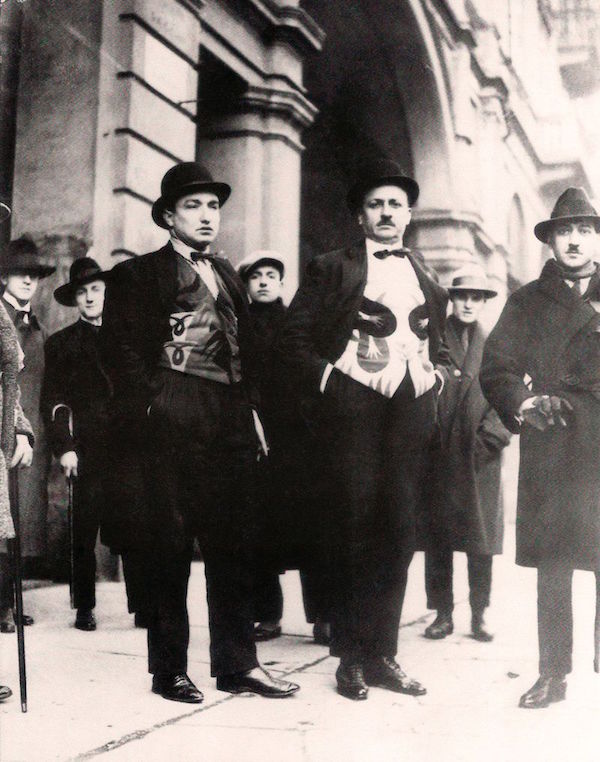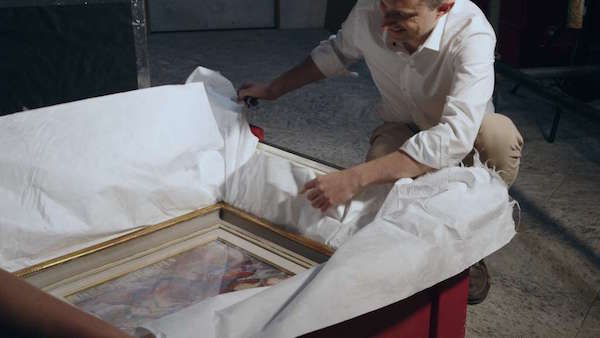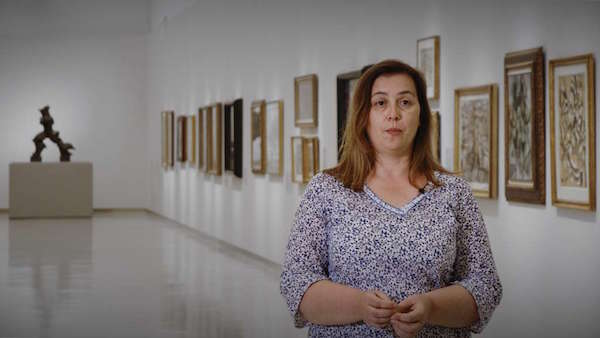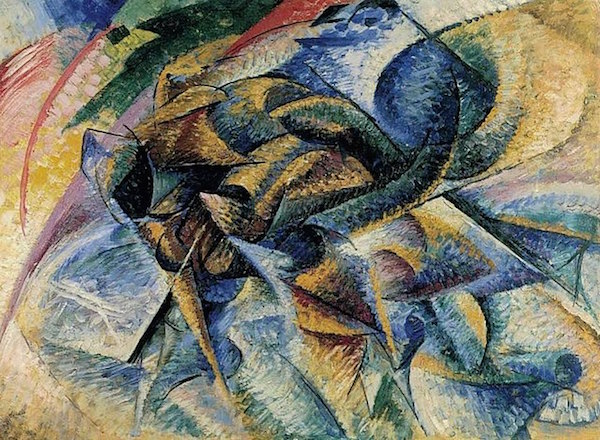Umberto Boccioni, Matter, 1912. Oil on canvas, 226 x 150 cm. Gianni Mattioli Collection, Museo del Novecento, Milan
And it is precisely during the making of the documentary FORMIDABLE BOCCIONIwritten by Eleonora Zamparutti and Piero Muscarà, directed by Franco Rado and produced by ARTE.it Originals with ITsART and Rai Cultura, now available on the ITsART platform, we met two central protagonists of this story: Giacomo Mattioli, grandson of the great collector Gianni, and Danka Giacon, curator of the Museo del Novecento. Here’s what they told us.

From left: Fortunato Depero, the young Gianni Mattioli (in the center with the cap) and Filippo Tommaso Marinetti I Public Domain Wikimedia Commons
“My grandfather started buying paintings after World War II, but he was a friend of the Futurists throughout his youth,” recalls Giacomo Mattioli: “He was a poor boy who ran away from home at 16. In the Futurists, and in particular in Fortunato Depero, he almost found the figure of a father. He loved the Futurists because they represented modernity, the break with traditional bourgeois values that he could not stand as a Protestant and the son of separated parents. But he didn’t have the money to buy the paintings, he found it hard to eat. After the war he began like many Milanese collectors: they were art lovers, they were friends of the artists, and they invested in works of art. Unlike others, however, Mattioli thought that a collection should also have a social purpose ”.
How come?
“It was an idea that he had developed during the war together with Fernanda Wittgens, his cousin, friend and later superintendent of Milan, with whom he had managed to save several Jews from deportation. Mattioli was deeply impressed by the massacres of the Nazis, especially that of Meina who lived in a very dramatic way. He thought that art could help people stay more human, more true. So with Fernanda they lit what they called ‘the torch of art’. Mattioli rented an apartment in via Senato, which he personally opened to the public on Saturdays, Sundays or on request, to show people things that were not yet in museums. He understood that Futurism and Metaphysics would be the two main movements of Italian modern art. It is no coincidence that he built the collection in a very short time, a sign that he had very clear ideas about the history of art at the beginning of the twentieth century ”.
Your grandfather understood the value of Futurism before critics and art historians …
“My grandfather understood that Futurism posed a fundamental theoretical question: what is art? What does it mean to make a work of art? The Futurists had been the first to ask, anticipating a bit all the avant-gardes of the twentieth century. Mattioli had started as a journalist and was interested in the relationship of art with the public, with society. Futurism was modernity because it spoke to everyone, opening art to new questions ”.

An image from the documentary “FORMIDABILE BOCCIONI”: Giacomo Mattioli with a painting from his grandfather’s collection
Among the masterpieces of the Mattioli Collection there is Matterthe painting by Umberto Boccioni that from tomorrow will close the Futurist Gallery at the Museo del Novecento …
“My grandfather bought Matter because he considered it the great masterpiece, the symbolic work of Boccioni. It was a very difficult and economically demanding operation. Then he bought those Boccioni linked to the great exhibition in 1912 in Paris. He tried to purchase at least one work by each of the artists who had exhibited at Galerie Barnheim Jeune: Solidity in the fog of Russolo, the Dancer by Severini … “.
After a long journey, the Mattioli Collection has found a home in Milan. In the rooms of the Museo del Novecento he will finally be able to speak to a large audience as his founder wished …
“I am very happy about it, because my grandfather was also the protagonist of the arrival of the very first group of works by the Futurists in the Milanese public museums. I’m talking about the collection of Felice Azzari, a futurist close to Depero who committed suicide. In the 1930s Mattioli acted as an intermediary in the operation between Azzari’s father, the Municipality of Milan and the Turin industrialist Ausonio Canavese, who agreed to buy the works and donate them to the city ”.
“In addition to being the city of Mattioli, Milan played a leading role in the art of the twentieth century, in particular of the avant-garde starting from Futurism”, observes Danka Giacon, curator of the Museo del Novecento. And by a very lucky coincidence, Piazza Duomo – where the museum is located – was the heart of the life of the Futurists in the city. “Around Piazza Duomo”, continues the curator, “there were the main meeting places of the artists of the movement: the Salvini Café and the Marchesi Pastry Shop, where the first galleries, the Society of the Artistic Family, gathered to discuss animatedly, which supported artists not yet established. In Piazza Duomo there was also the studio of Gaetano Previati, who for the generation of the Futurists was a great teacher and a point of reference. We know, for example, that Umberto Boccioni used to frequent him… ”.

From the documentary “FORMIDABILE BOCCIONI”: curator Danka Giacon in the Futurist Gallery of the Museo del Novecento
The Museo del Novecento has always had a collection of futurist works of exceptional value …
“The Museo del Novecento has the good fortune to collect a unique collection in the world of futurist works of art, in particular by Umberto Boccioni: it is the public collection that houses the largest number of the artist’s works. The collection actually began to form at the beginning of the 20th century, well before the birth of the museum. The first painting was the Portrait of Mrs. Virginia, just by Boccioni, acquired for the GAM around 1916. A work with still Divisionist ways, because it was, yes, daring, to buy the paintings of an avant-garde artist at that time, but the calmness of a recognizable subject was still preferred . The true futurist masterpieces will enter the collection in the 1930s thanks to the Canavese legacy. In the same period, with the intermediation of Marinetti, the Municipality of Milan acquired two fundamental bronzes by Boccioni: Unique forms of continuity in space And Development of a bottle. Marinetti, who had inherited the plaster models of the sculptures, had managed, thanks to a public grant, to carry out the castings in the Battaglia foundry in Milan. Finally, from the 1990s and early 2000s, I bought the important collection of Riccardo and Magda Jucker, with fundamental works such as Elasticity and the Drinkerand the donation of Pina Antonini, with the early twentieth century masterpiece The Twilight”.
What will be the added value of the Mattioli Collection in the visit to the Museo del Novecento?
“The Mattioli Collection is a very rich and important collection, which adds great futurist masterpieces to the heritage of the Museo del Novecento. It will dialogue with another important collection of the same period, the one put together by Riccardo Jucker precisely after World War II ”.

Umberto Boccioni, Dynamism of a cyclist, 1913. Mattioli I Jackrosso Collection, CC BY-SA 4.0, via Wikimedia Commons
Read also:
• Gianni Mattioli’s jewels: a millionaire collection arriving at the Museo del Novecento
• Gino Agnese tells Boccioni, the talent rejected in drawing who won the challenge of the twentieth century
• Boccioni and Vittoria, the futurist and the princess. Chronicle of a love outside the box
• That time when the futurists, unknown and misunderstood, exhibited at the Barnheim-Jeune Gallery (selling only one painting)
• “FORMIDABLE BOCCIONI”: the futurist genius in a docufilm
• Boccioni’s masterpieces to see in Italy
• Traveling with Boccioni. The masterpieces to be admired in the world

